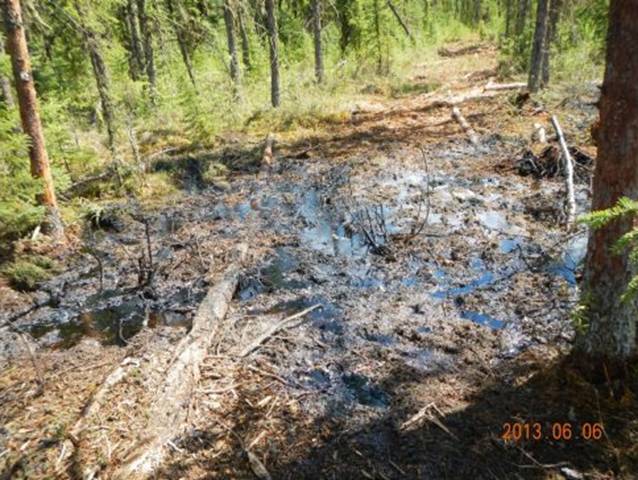Alberta oil sands spills have been going on for weeks with no end in sight – ‘This is a new kind of oil spill and there is no off button’
By Emma Pullman and Martin Lukacs
19 July 2013 (The Toronto Star) – Oil spills at a major oil sands operation in Alberta have been ongoing for at least six weeks and have cast doubts on the safety of underground extraction methods, according to documents obtained by the Star and a government scientist who has been on site. Canadian Natural Resources Ltd. has been unable to stop an underground oil blowout that has killed numerous animals and contaminated a lake, forest, and muskeg at its operations in Cold Lake, Alta. The documents indicate that, since cleanup started in May, some 26,000 barrels of bitumen mixed with surface water have been removed, including more than 4,500 barrels of bitumen. The scientist said Canadian Natural Resources is not disclosing the scope of spills in four separate sites, which have been off bounds to media and the public because the operations are on the Cold Lake Air Weapons Range, where there is active weapons testing by the Canadian military. […] The documents and photos show dozens of animals, including beavers and loons, have died, and that 30,600 kg of oily vegetation has been cleared from the latest of the four spill zones. The company’s operations use an “in situ” or underground extraction technology called “cyclic steam stimulation,” which involves injecting thousands of gallons of superhot, high-pressure steam into deep underground reservoirs. This heats and liquefies the hard bitumen and creates cracks through which the bitumen flows and is then pumped to the surface. The scientist, who asked not to be named for fear of losing their job, said the operation was in chaos. “Everybody (at the company and in government) is freaking out about this,” said the scientist. “We don’t understand what happened. Nobody really understands how to stop it from leaking, or if they do they haven’t put the measures into place.” In response to emailed questions from the Star, Canadian Natural Resources said it was co-operating with the regulator. “We are investigating the likely cause of the occurrence, which we believe to be mechanical,” the company said. “Canadian Natural has existing groundwater monitoring in place and we are undertaking aquatic and sediment sampling to monitor and mitigate any potential impacts. As part of our wildlife mitigation program, wildlife deterrents have been deployed in the area to protect wildlife. “We are saddened that unfortunately some animal fatalities occurred between the time of the incident and the deployment of our animal deterrent systems. All of the fatalities have been reported to the Alberta Energy Regulator.” The company added that it has “taken appropriate steps to ensure no additional impact to wildlife or the environment and that the incident site is reclaimed.” Canadian Natural Resources did not respond to the charge that they aren’t disclosing the scope of the spills. Oil companies have said in situ methods are more environmentally friendly than the open-pit mining often associated with the Alberta oil sands, but in situ is more carbon and water-intensive. “In the course of injecting steam they’ve created fractures from the reservoir to the surface that they didn’t expect,” said the scientist, who is speaking out over concern that neither the company nor Alberta’s regulatory bodies would properly address the situation. On Thursday, the Alberta Energy Regulator confirmed there were four spills in the last few months, and ordered Canadian Natural Resources to restrict its steam injections and enhance monitoring at the operations in Cold Lake. Regulator official Bob Curran said the latest spill is spread across 40 hectares. […] “This is a new kind of oil spill and there is no ‘off button,’ ” said Keith Stewart, an energy analyst with Greenpeace who teaches a course on energy policy and environment at the University of Toronto. “You can’t cap it like a conventional oil well or turn off a valve on a pipeline. “You are pressurizing the oil bed so hard that it’s no wonder that it blows out. This means that the oil will continue to leak until the well is no longer pressurized,” which means the bitumen could be seeping from the ground for months. [more]
‘Nobody understands’ spills at Alberta oil sands operation

Typical "We're not responsible" response while everything turns to shit.
Why do humans continue to allow this sort of malfeasance?